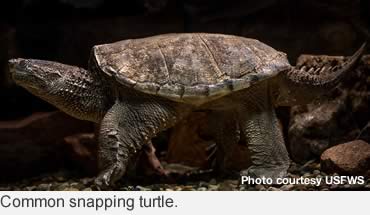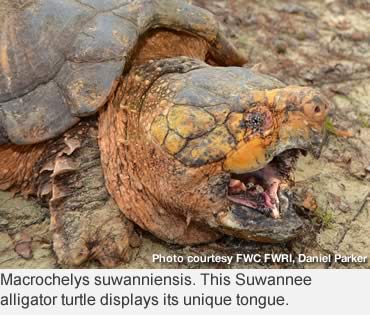Photo: Alligator snapping turtle.
There’s no doubt about it. Snapping turtles are survivors. Really, really old survivors.
Their fossilized remains tell scientists their ancestors called earth home 230 million years ago in the Triassic Period, time before the dinosaurs arrived!
Since the extinction of dinosaurs near the end of the Cretaceous Age, which began around 145.5 million years ago and ending 66 million years ago, turtles remain among earth’s oldest living creatures, even if scientists debate whose family tree they belong to.
Today you will find the prehistoric cousins—the common snapping turtle and the alligator snapping turtle—in freshwater environments east of the Rocky Mountains and in Mexico and Central America. The common snapping turtle lives in eastern North America, but the alligator snapping turtle’s habitat is contained primarily in Texas, Louisiana and east in Alabama, Florida and Georgia waterways.
It wasn’t until 2014 that DNA researchers learned three separate, distinct species of alligator snapping turtles live in rivers in Georgia and Florida. The Suwannee alligator turtle is found in Florida and Georgia and only in the Suwannee River. The Apalachicola alligator snapping turtle calls Florida, Georgia and Alabama home. They join their relative, the Pensacola Bay alligator snapping turtle.
Snapping turtles are fascinating creatures to many. However, there are two things to keep in mind, according to Rick O’Connor, University of Florida IFAS Sea Grant Extension Agent, if you encounter one. First, know that all turtles are snapping turtles, and be cautious, because secondly, all snapping turtles are dangerous.
They are also very large.
 An adult common snapping turtle’s carapace or shell measures 8 to 12 inches long and it has prominent ridges on its upper shell. It tips the scale between 10 and 35 pounds, and its tail is often as long or longer than the carapace. As the turtle grows older, it grows a larger carapace, the ridges smooth out and it and becomes heavier. Some very old common snapping turtles have weighed 100 or more pounds.
An adult common snapping turtle’s carapace or shell measures 8 to 12 inches long and it has prominent ridges on its upper shell. It tips the scale between 10 and 35 pounds, and its tail is often as long or longer than the carapace. As the turtle grows older, it grows a larger carapace, the ridges smooth out and it and becomes heavier. Some very old common snapping turtles have weighed 100 or more pounds.
Common snappers have large heads, long necks and a sharp, hooked upper beak with a rough cutting edge used to tear food. They can be mistaken for their cousins, but alligator snapping turtles are even larger.
In fact it is the largest freshwater turtle in North America. It looks as prehistoric as its ancient relatives, and typically lives in slow-moving, deep river waters. One of its unique characteristics is the pink worm-like lure attached to its tongue. It will sit submerged with a wide open mouth and wiggle its tongue-lure to entice the unwary to investigate, which quickly becomes lunch.
The speed and force snapping turtles use in rapidly closing their mouth should be respected, O’Connor warns.
The average adult alligator snapping turtle has a 15- to 26-inch carapace, with an adult weight between 150 and 175 pounds. The massive shell also has three prominent ridges, running back to front, and the turtle’s head is very large, with a very hooked beak above wide, gaping, strong jaws. It also has large strong claws and webbed toes.
Fish, frogs, snakes, snails, worms, clams, mussels, crayfish, aquatic plants and other turtles are satisfactory meals for the alligator snapping turtle. Common snapping turtles enjoy many of the same foods, as well as smaller turtles, unwary birds and small mammals.
 While the common snapping turtle is not endangered, the alligator snapping turtle is of concern. It is protected against hunting in Alabama, Georgia, Florida, Tennessee, Kentucky, Mississippi, Louisiana, Texas, Oklahoma and Missouri.
While the common snapping turtle is not endangered, the alligator snapping turtle is of concern. It is protected against hunting in Alabama, Georgia, Florida, Tennessee, Kentucky, Mississippi, Louisiana, Texas, Oklahoma and Missouri.
At one time alligator snapping turtles were commercially harvested as the main ingredient in turtle soup.
Decades later, this led to drastically reduced numbers and because of their offspring’s low survival rate. Also they do not mature until they are 11 to 13 years old. At maturity, they do not always produce eggs each year.
The sex of their hatchlings is determined by the nest temperature.
Throughout much of the country, as aquatic habitats are polluted or commercially developed, snapping turtles often have relocated to more urban areas where they can survive.
“Snapping turtles are animals that can live in almost any aquatic habitat as long as their basic needs for survival are met,” according to Bill Peterman, a researcher at the University of Missouri.
Snapping turtles aren’t aggressive animals and don’t bite unless provoked, Peterman says, but if you encounter one in a non-forested or urban environment his best advice is to simply leave it alone.
–Resources: Alabama Department of Conservation and Natural Resources, NW District University of Florida, Florida Fish and Wildlife Conservation Commission, Phys.Org., University of Georgia Savannah River Ecology Laboratory, Georgia Department of Natural Resources.